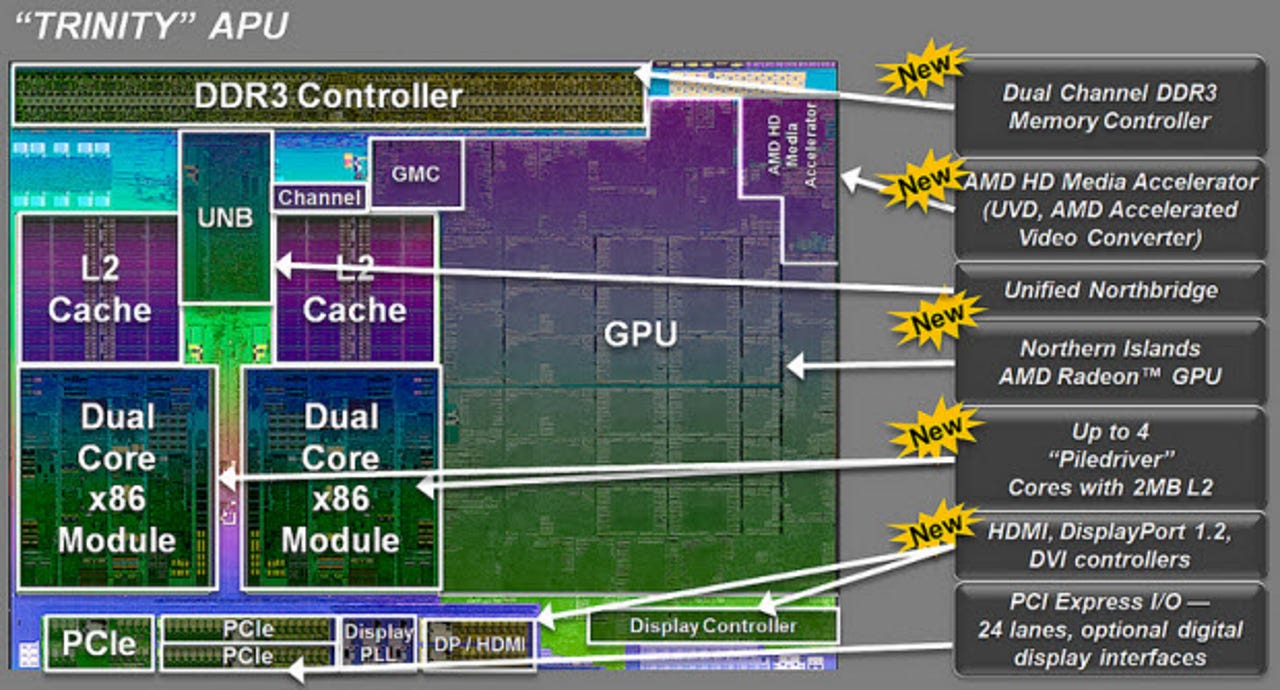Building an AMD 'Trinity' desktop PC

Now that AMD has officially released new desktop versions of its A-series APUs (Accelerated Processing Units), let's take a look at what you'd need to take advantage of these new processors.
First, a little background. These processors are the second-generation iteration of AMD's all-in-one CPU and GPU silicon. They follow-on from the first-generation "Llano" APUs, but they offer a solid advantage over the old parts in every respect.
Mobile versions of the "Trinity" APUs debuted back in May, but it has taken some time for AMD to get desktop versions ready for release. Put simply, "Trinity" is AMDs answer to Intel's "Ivy Bridge" processors and contain much of the same functionality, such as a GPU and PCI Express connectivity. The idea is to integrate as much onto the chip as possible so as to save space, save power, and reduce costs.
Here is the current desktop "Trinity" line up:
| Model | Cores | Speed/Turbo (GHz) | L2 (MB) | GPU Clock | TDP | Price $ |
| A10-5800K | 4 | 3.8/4.2 | 4 | 800 | 100 | 122 |
| A10-5700K | 4 | 3.4/4.0 | 4 | 760 | 65 | 122 |
| A8-5600K | 4 | 3.6/3.9 | 4 | 760 | 100 | 101 |
| A6-5500 | 4 | 3.2/3.7 | 4 | 760 | 65 | 101 |
| A6-5400K | 2 | 3.6/3.8 | 1 | 760 | 65 | 67 |
| A6-5300 | 2 | 3.4/3.6 | 1 | 724 | 65 | 53 |
Note the processors featuring the "K" suffix have unlocked multipliers for overclocking.

If you're interested in building a "Trinity" based desktop system, here's what you will need. Note that I do not include a chassis or peripherals in the build, and you will also need an operating system -- most likely Windows -- to install onto the system.
Processor
Let's start with the most obvious component -- the processor.
After a quick shop around I've found four different models in stock. There's the top-of-the-line A10-5800K for $130, the A8-5600K for $110, the A6-5400K for $75, and the A4-5300 for $65. Take your pick of what you need based on your budget and performance requirements.
Motherboard
After you've picked the processor, it's time to choose the motherboard.
To make use of the "Trinity" APUs you will need a motherboard with the new Socket FM2. No amount of hammering will get these new APUs into existing Socket FM1 motherboards. Given that Intel made its Sandy Bridge and Ivy Bridge processors backward compatible, this socket switch by AMD might be seen by some as unnecessary.
There are three compatible chipsets for "Trinity" processors. A55 and A75 have been around for some time on Socket FM1 motherboards, but the A85X is new and brings some new enthusiast and gaming features to the Fusion platform. That said, there's not much difference between A75 and A85X chipsets.
Socket FM2 motherboards are available from a whole raft of manufacturers, including BioStar, ASUS, ASRock, MSI and Gigabyte.
Since these are relatively cheap processors, I don't see much point in spending too much on the motherboard, so my eye is drawn to the BioStar TA75MH2 running the A75 chipset for $80, or the BioStar Hi-Fi A85W with the newer A85X chipset for $95. Both are solid boards with a broad array of features, and both feature USB 3.0 ports. The main difference between the two boards is that the BioStar TA75MH2 has 2 x 240 pin DDR3 slots, while the BioStar Hi-Fi A85W has 4 x 240 pin DDR3 slots.
RAM
Nothing fancy here. 4GB (2 x 2GB) of Mushkin Enhanced DDR3 1066/PC3 8500 will do the trick for $20.
Power Supply Unit
To bring your system to life you will need a power supply unit (PSU). Again, cheap and cheerful is what you want and I like the Thermaltake TR2 W0070RUC 430W PSU for $40.
Storage
Finally, some storage.
What you pick here is really down to your budget and storage needs. The sweet spot in terms of price/storage seems to be around the 1TB mark, and the Samsung Spinpoint F3 HD103SJ for $85 is a very good deal.
Image source: AMD.